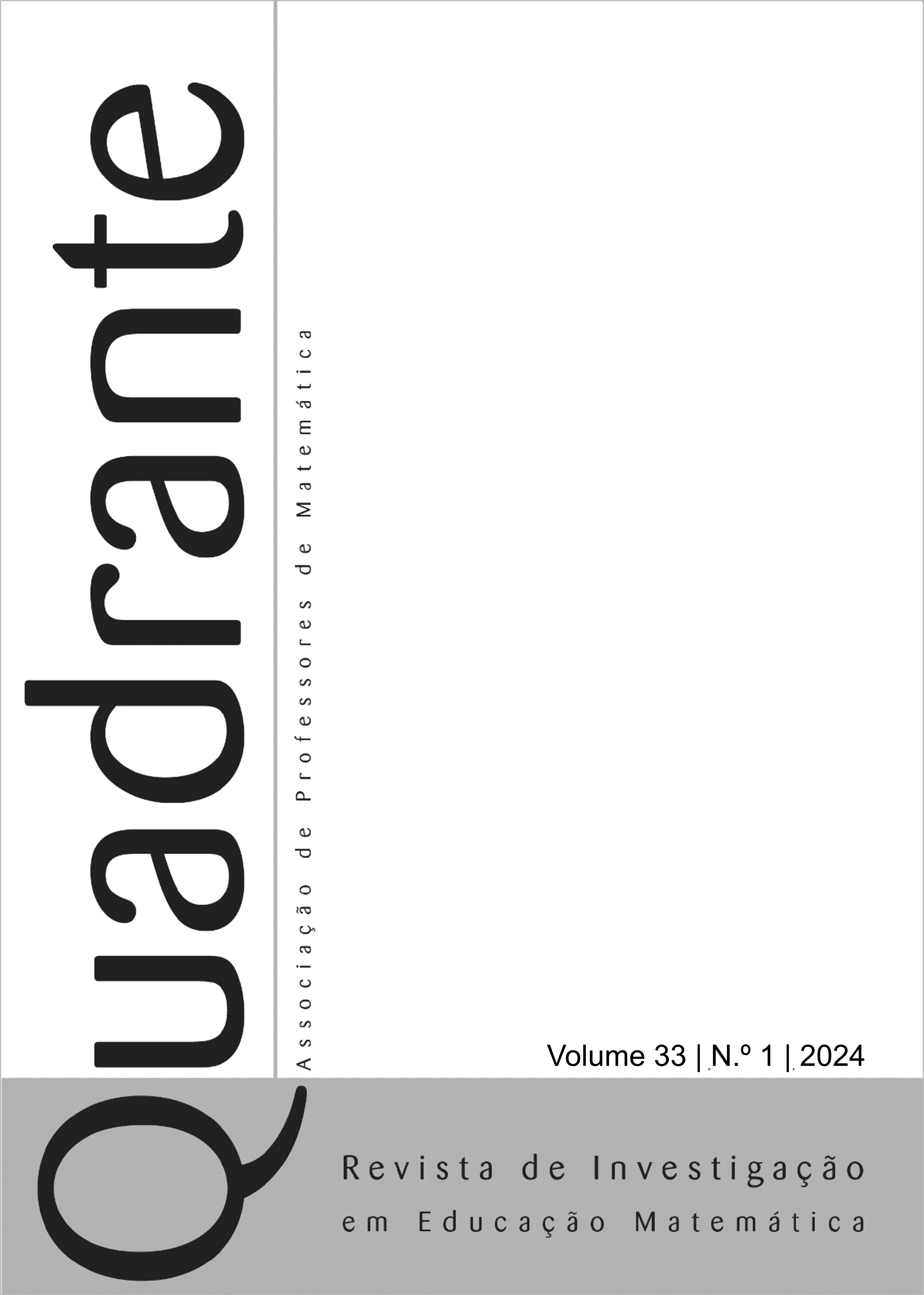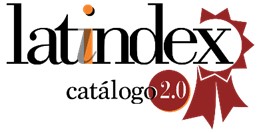O conhecimento intuitivo de crianças sobre o conceito de medida
DOI:
https://doi.org/10.48489/quadrante.32674Palavras-chave:
anos iniciais, conhecimento intuitivo sobre medidas, unidades de medida, invariantes lógicosResumo
O presente estudo tem por objetivo examinar como crianças com diferentes perfis quanto ao conhecimento intuitivo que possuem sobre medidas lidam com dois dos princípios invariantes constitutivos dessa noção em relação a diferentes grandezas (capacidade, massa, distância e comprimento). Cinquenta crianças do 1.º e do 2.º ano do Ensino Fundamental realizaram duas tarefas. Uma tarefa examinava a capacidade de reconhecer a unidade apropriada para medir uma dada grandeza, e a outra, a relação inversa entre o tamanho da unidade de medida e a quantidade de unidades necessárias para medir uma dada grandeza. O perfil dos participantes foi definido por meio do emprego da Análise de Agrupamentos, obtendo-se dois grupos: um formado por aqueles com um bom domínio sobre medidas e outro por aqueles com um domínio mais limitado. O reconhecimento da unidade apropriada para medir uma dada grandeza é a habilidade que se desenvolve primeiro, ainda que de maneira elementar, e que varia entre as diferentes grandezas. A compreensão da relação inversa entre o tamanho da unidade de medida e a quantidade de unidades necessárias para medir uma dada grandeza independe da grandeza a ser medida e da unidade a ela associada. Os resultados relativos às dificuldades e possibilidades das crianças são discutidos a partir da associação entre a noção de medida e os invariantes lógicos que a constituem.
Referências
Battista, M. T. (2006). Understanding the development of students' thinking about length. Teaching Children Mathematics, 13(3), 140–146. https://doi.org/10.5951/TCM.13.3.0140
Bellemain, P. M. B., Bibiano, M. F. de A., & Souza, C. F. de. (2018). Estudar grandezas e medidas na educação básica. Em Teia. Revista de Educação Matemática e Tecnológica Iberoamericana, 9(1), 1–16. https://doi.org/10.36397/emteia.v9i1.234920
Brasil (2018). Ministério da Educação. Base Nacional Comum Curricular. Brasília.
Bragg, P., & Outhred, L. (2004). A measure of rulers: The importance of units in a measure. Proceedings of the 28th Annual Conference of the International Group for the Psychology of Mathematics Education, (pp. 159–165). IGMPE.
Carpenter, T. P., & Lewis, R. (1976). The development of the concept of a standard unit of measure in young children. Journal for research in Mathematics Education, 7(1), 53-58. https://doi.org/10.5951/jresematheduc.7.1.0053
Cheeseman, J., Mcdonough, A., & Clarke, D. (2011). Investigating children’s understanding of the measurement of mass. In J. Clark, B. Kissane, J. Mousley, T. Spencer, & S. Thornton (Eds.), Mathematics: Traditions and [New] Practices (Vol. 1, pp. 174–182). Australian Association of Mathematics Teachers and the Mathematics Education Research Group of Australasia.
Curry, M., Mitchelmore, M., & Outhred, L. (2006). Development of children’s understanding of length, area, and volume measurement principles. Proceedings of the 30th Conference of the International Group for the Psychology of Mathematics Education, (pp. 377–384). IGPME
Guimarães, G., Cavalcanti, M., & Evangelista, B. (2015). Compreensão de Escala nos Anos Iniciais. In R. Borba & G. Guimarães (Eds.). Pesquisa e atividades para o aprendizado matemático na educação infantil e nos anos iniciais do ensino fundamental (pp. 47–49). SBEM. http://www.sbembrasil.org.br/ebook/ebook.pdf
Kamii, C. (2006). Measurement of length: How can we teach it better? Teaching Children Mathematics, 13(3), 154–158. https://doi.org/10.5951/TCM.13.3.0154
Lee, S. (2012). Toddlers as mathematicians? Australasian Journal of Early Childhood, 37(1), 30–37.
Lefevre, J.-A., Skwarchuk, S-L., & Smith-Chant, B. (2009). Home numeracy experiences and children's math performance in the early school years. Canadian Journal of Behavioural Science, 41(2), 55–66. https://doi.org/10.1037/a0014532
MacDonald, A. (2010). Heavy thinking: Young children's theorizing about mass. Australian Primary Mathematics Classroom, 15(4), 4–8.
MacDonald, A., & Lowrie, T. (2011). Developing measurement concepts within context: Children’s representations of length. Mathematics Education Research Journal, 23(1), 27–42. https://doi.org/10.1007/s13394-011-0002-7
McDonough, A., & Cheeseman, J. (2014). Young learners' understandings about mass measurement: Insights from an open-ended task. Proceedings of the 38th Conference of the International Group for the Psychology of Mathematics Education and the 36th Conference of the North American Chapter of the Psychology of Mathematics Education, (pp. 193–200). IGPME
Mcdonough, A., Cheeseman, J., & Ferguson, S. (2013). Young children’s emerging understandings of the measurement of mass. Australasian Journal of Early Childhood, 38(4), 13–20. https://doi.org/10.1177/1836939113038004
Miller, K. F. (1989). Measurement as a tool for thought: The role of measuring procedures in children’s understanding of quantitative invariance. Developmental Psychology, 25, 589–600. https://doi.org/10.1037/0012-1649.25.4.589
Moura, A. L., & Lorenzato, S. (2001). O medir de crianças pré-escolares. Zetetiké, 9, 7–42. https://doi.org/10.20396/zet.v9i15-16.8646932
Mulligan, J., Mitchelmore, M., & Prescott, A. (2005). Case studies of children’s development of structure in early mathematics: A two-year longitudinal study. Proceedings of the 29th Confe-ren¬ce of the International Group for the Psychology of Mathematics Education, (pp. 1–8). IGPME.
Nunes, T., & Bryant, P. (2007). Crianças fazendo matemática. Artes Médicas.
Nunes, T., Light, P., & Mason, J. (1993). Tools for thought: The measurement of length and area. Learning and Instruction, 3, 39–54. https://doi.org/10.1016/S0959-4752(09)80004-2
Nunes, T., Light, P., & Mason, J. (1995). Measurement as a social process. Cognition and Instruction, 13(4), 585–587. https://doi.org/10.1207/s1532690xci1304_9
Piaget, J., & Inhelder, B. (1983). O desenvolvimento das quantidades físicas na criança. Zahar.
Piaget, J., Inhelder, B., & Szeminska, A. (1960). The child’s conception of geometry. Routledge.
Piaget, J., & Moreau, A. (2001). The inversion of arithmetic operations. (R. L. Campbell, Trans.). In J. Piaget (Ed.), Studies in Reflecting Abstraction (pp. 69–86). Psychology Press.
Pytlak, M., & Maj-Tatsis, B. (2021). Young children’s intuitive understanding of measure sense and measurement. In J. Novotá, & H. Moraová (Eds.), Proceedings of the International Symposium Elementary Mathematics Teaching, (pp. 338–347). SEMT.
Serrazina, L., & Rodrigues, M. (2018). Formação de professores e desenvolvimento do sentido de número. In R. F. Carneiro, A. C. de Souza, & L. de F. Bertini (Eds.), A Matemática nos anos iniciais do ensino fundamental: Práticas de sala de aula e de formação de professores (pp. 137–161). SBEM. http://www.sbembrasil.org.br/files/ebook_matematica_iniciais.pdf .
Sharif-Rasslan, A., & Tabajah-Awawdy, J. (2022). Strategies used by kindergarten children to cover “maximal area” inside a rectangle. Journal of Cognitive Education & Psychology, 21(2). https://doi.org/10.1891/JCEP-2021-0005
Silva, C. X., & Lousada, F. M. (2001). Medir é comparar. Ática.
Spinillo, A. G. (2006). O sentido de número e sua importância na educação matemática. In M. R. F. Brito, (Ed.), Solução de problemas e a matemática escolar (pp. 83–111). Alínea.
Spinillo, A. G. (2018). Number sense in elementary school children: the uses and meanings given to numbers in different investigative situations (pp. 639–650). In K. Gabrieke, H. Forgasz, M. Graven, A. Kuzniak, E. Simmt, & B. Xu (Eds.), Invited lectures from the 13th International Congress on Mathematical Education, (pp. 639–650). Springer.
Spinillo, A. G. & Batista, R. F. (2009). A sense of measurement: what do children know about the invariant principles of different types of measurement? Proceedings of the 33rd Conference of the International Group for the Psychology of Mathematics Education, (pp. 161–168). IGPME
Spinillo, A. G. & Martins, R. M. F. B. (2015). Os princípios invariantes da noção de medida investigados a partir da perspectiva de sentido numérico. Temas em Psicologia, 23(1), 97–109. https://doi.org/10.9788/TP2015.1-07
Szilágyi, J., Clements, D. H., & Sarama, J. (2013). Young children's understandings of length measurement: Evaluating a learning trajectory. Journal for Research in Mathematics Education, 44(3), 581–620. https://doi.org/10.5951/jresematheduc.44.3.0581
Thompson, I. (2008). Teaching and learning early number. McGraw-Hill.
Torbeyns, J., Peters, G., De Smedt, B., Ghesquière, P., & Verschaffel, L. (2018). Subtraction by addition strategy use in children of varying mathematical achievement level: A choice/no-choice study. Journal of Numerical Cognition, 4(1), 215–234. https://doi.org/10.5964/jnc.v4i1.77
Van de Walle, J. A. (2009). Matemática no ensino fundamental: Formação de professores e aplicação em sala de aula. Artmed.
Vergnaud, G. (1997). The nature of mathematical concepts. In T. Nunes, & P. Bryant (Eds.). Learning and teaching mathematics: An international perspective, (pp. 5–28). Psychology Press.
Vergnaud, G. (2003). A gênese dos campos conceituais. In E. P. Grossi (Ed.), Por que ainda há quem há não aprende? A teoria, (pp. 21–64). Vozes.











